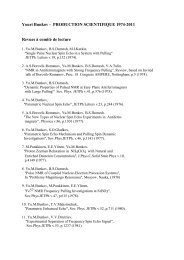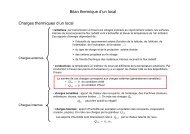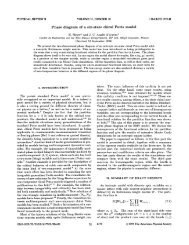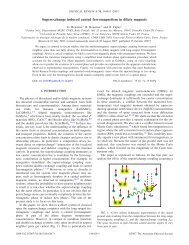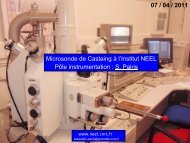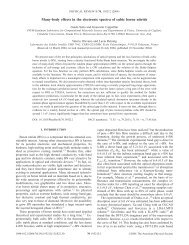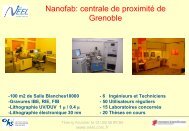Activity Report 2010 - CNRS
Activity Report 2010 - CNRS
Activity Report 2010 - CNRS
You also want an ePaper? Increase the reach of your titles
YUMPU automatically turns print PDFs into web optimized ePapers that Google loves.
SCANNING GATE<br />
NANOELECTRONICS<br />
In the framework of Vincent Bayot’s Chair<br />
of Excellence, two major results were<br />
obtained by scanning gate microscopy<br />
(SGM): a theoretical understanding of<br />
SGM images in the coherent regime of<br />
transport both in the presence of defects<br />
and weak magnetic field; and the<br />
discovery of Coulomb islands in a<br />
quantum Hall interferometer.<br />
In the quantum Hall (QH) regime, near<br />
integer Landau level filling factors,<br />
electrons should be perfectly transmitted<br />
through spatially separated edge states<br />
(Fig. 2).<br />
SGM uses the electrically polarized tip of<br />
a low-temperature AFM to scan above a<br />
semiconductor device while the conductance<br />
changes, due to the tip perturbation,<br />
are simultaneously mapped in real<br />
space. Previously, we have applied the<br />
SGM technique to InGaAs-based quantum<br />
rings (QRs) at low temperature and<br />
under the effect of an external magnetic<br />
field (Hackens et al., Nature Phys 2006,<br />
Martins et al., PRL 2007). When the AFM<br />
tip scans over the QR surface, fringes are<br />
observed in the tip-induced conductance<br />
changes which are essentially radial with<br />
the QR. To understand the physics behind<br />
SGM experiments, we have focused on<br />
the correspondence between the local<br />
density of states (LDOS) and SGM<br />
conductance images by including an<br />
external magnetic field in the<br />
simulations. We also generate a realistic<br />
potential profile to account for disorder,<br />
and include many conduction channels<br />
contributing to the transport. We find<br />
that, in contrast with the current density<br />
distribution, the LDOS can often be<br />
determined by recursive semi-classical<br />
trajectories with energies close to the<br />
Fermi energy. As a result, the<br />
correspondence between LDOS and SGM<br />
images is clearly established (Fig. 1).<br />
Fig. 2: An artist’s view of edge states in the<br />
quantum ring confining potential. The tip (in<br />
green) induces a local perturbation of the<br />
potential that can be scanned over the<br />
quantum Hall interferometer.<br />
However, in mesoscopic systems,<br />
electronic transmission turns out to be<br />
more complex, giving rise to a large<br />
spectrum of magnetoresistance<br />
oscillations. To explain these<br />
observations, recent models (Rosenow et<br />
al., PRL 2007) put forward the theory<br />
that, as edge states come close to each<br />
other, electrons can hop between<br />
counterpropagating edge channels, or<br />
tunnel through Coulomb islands, giving<br />
rise to a new kind of Coulomb blockade<br />
effect. We have used SGM to<br />
demonstrate the presence of QH Coulomb<br />
islands, and reveal the spatial structure<br />
of transport inside a QH interferometer.<br />
The locations of electron islands are<br />
found by modulating the tunneling<br />
between edge states and confined<br />
electron orbits, i.e. the SGM polarized tip<br />
is used to modulate Coulomb blockade,<br />
resulting in concentric fringes<br />
surrounding the active island (Fig. 3).<br />
HIGHLIGHT : NANO-CHARACTERIZATION AND METROLOGY<br />
Fig. 1: Comparison between the LDOS (A) and<br />
conductance variation images (B) when<br />
negatively charged defects are included in the<br />
system.<br />
Moreover, by varying the Fermi<br />
level and magnetic field strength, we find<br />
that the LDOS and conductance images<br />
are periodical with the external field and<br />
that they bear the same periodicity as<br />
the Aharonov-Bohm effect. This finding<br />
strengthens our view that SGM in the<br />
weak tip-potential limit is the analogue of<br />
STM for imaging the electronic LDOS in<br />
buried open mesoscopic systems.<br />
Fig. 3: SGM image in the QH regime. The<br />
center of the resulting concentric fringes mark<br />
the position of the active quantum Coulomb<br />
island.<br />
Tuning the magnetic field, we<br />
were able to unveil a continuous<br />
evolution of active quantum Coulomb<br />
islands. This allows to decrypt the<br />
complexity of high-magnetic field<br />
magnetoresistance oscillations, and<br />
opens the way to further local-scale<br />
manipulations of QH localized states.<br />
CONTACTS<br />
vincent.bayot@uclouvain.be<br />
serge.huant@grenoble.cnrs.fr<br />
herve.courtois@grenoble.cnrs.fr<br />
FURTHER READING<br />
M. G. Pala et al., Nanotechnology, 20,<br />
264021 (2009)<br />
B. Hackens et al., Nature Communications<br />
1:39 (<strong>2010</strong>).<br />
12



